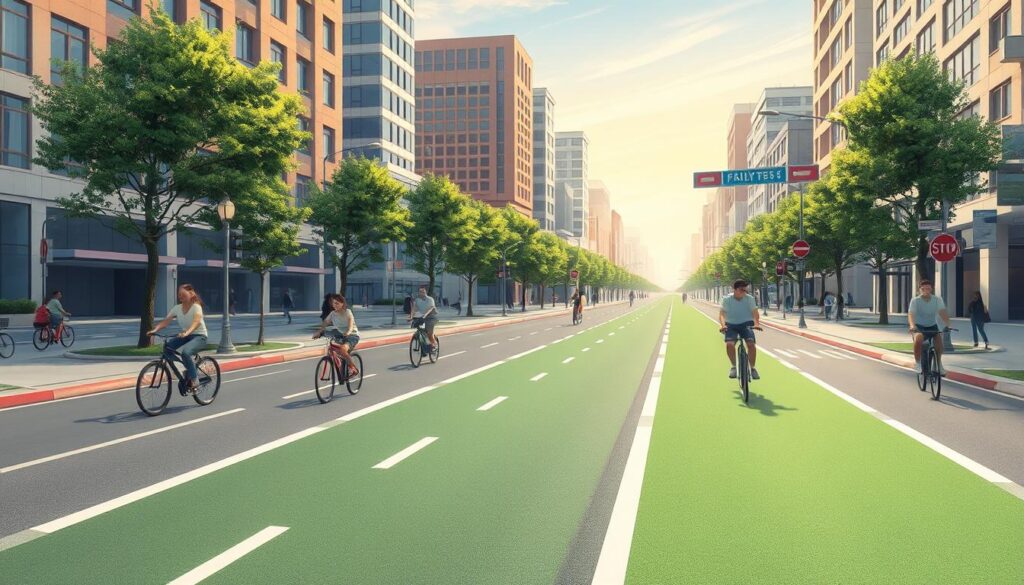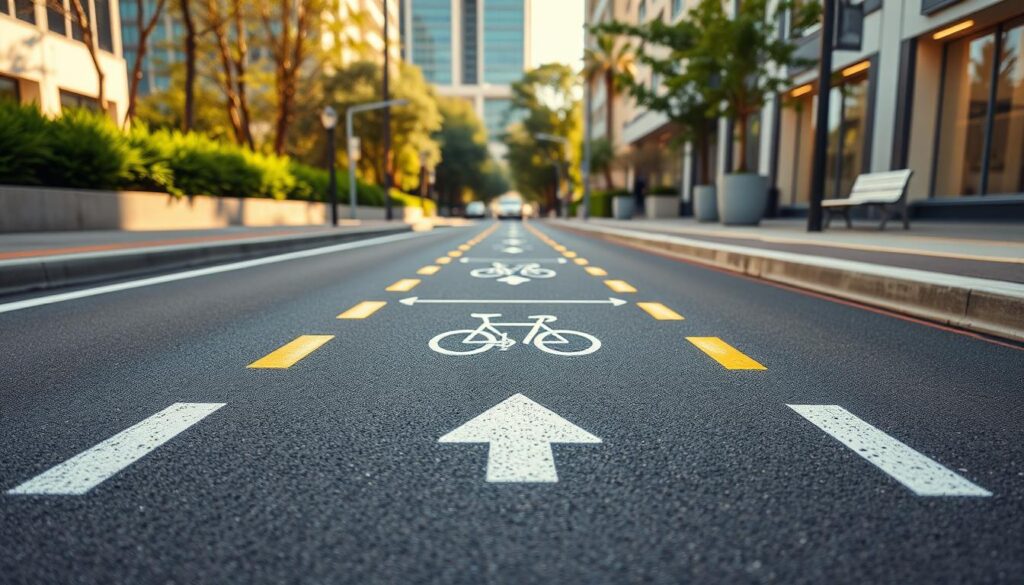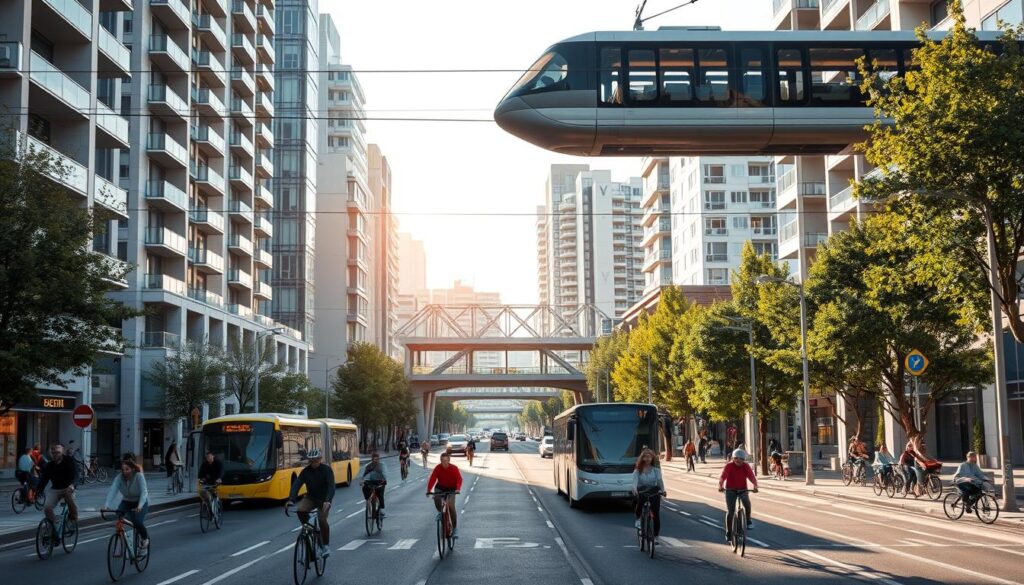Can a city’s transportation system be transformed to prioritize sustainability and efficiency? The answer lies in optimizing urban bike paths to enhance connectivity across the city.
According to the NYC DOT, bike ridership has reached an all-time high, with over 24,000 trips recorded over East River bridges during an average weekday. This surge underscores the need for sustainable transportation planning that incorporates safe and accessible bike routes.
By focusing on bike lane infrastructure design, cities can reduce traffic congestion and promote a healthier environment. The question is, how can cities achieve seamless connectivity through their bike paths?
Key Takeaways
- Efficient bike lane infrastructure is crucial for citywide connectivity.
- Sustainable transportation planning can reduce traffic congestion.
- Urban bike paths play a significant role in promoting a healthier environment.
- Optimizing bike ridership can lead to a more efficient transportation system.
- Safe and accessible bike routes are essential for enhancing citywide connectivity.
Importance of Bike Lane Infrastructure
Bike lane infrastructure plays a vital role in modern urban planning, offering numerous benefits for cities and their inhabitants. By providing safe and accessible cycling routes, cities can promote urban mobility, reduce environmental impact, and stimulate economic growth.
Benefits of Cycling for Urban Mobility
Cycling infrastructure is essential for enhancing urban mobility. A study found that every mile of protected bike lane added to streets created 1,100 daily bike trips and reduced vehicle trips by 15% to 20%. This shift not only decreases traffic congestion but also promotes a healthier lifestyle among citizens.
For instance, cities that have invested in city bike lane solutions have seen a significant increase in cycling as a mode of transportation. This is partly due to the enhanced safety and convenience offered by dedicated bike lanes.
Environmental Impact of Biking
The environmental benefits of biking are substantial. By reducing reliance on motor vehicles, cities can lower emissions and improve air quality. Biking is a zero-emission mode of transport that contributes to a cleaner environment.
Moreover, promoting biking as a primary mode of transportation can lead to a reduction in urban pollution. Cities can achieve their sustainability goals by incorporating sustainable urban design for bikes into their infrastructure plans.
| Mode of Transport | Emissions per Mile |
|---|---|
| Car | 0.41 kg CO2 |
| Bike | 0 kg CO2 |
Economic Advantages of Bike Infrastructure
Investing in bike infrastructure also has significant economic benefits. By enhancing bikeway design strategies, cities can attract businesses and tourists, boosting local economies. Moreover, bike-friendly cities often see an increase in property values and local spending.
For example, a city that implements comprehensive bike lane infrastructure can expect to see economic growth through increased tourism and local business patronage. To learn more about the broader impacts of cycling, visit https://gmtma.org/cycling-for-a-better-world/.
Key Components of Bike Lane Design
Bike lane design is a critical component of urban planning, directly impacting cyclist safety and mobility. Effective bike lane infrastructure is essential for fostering a culture of cycling in urban environments.

Types of Bike Lanes
There are several types of bike lanes, each designed to serve different needs and environments. Protected bike lanes, for instance, are segregated from vehicular traffic by physical barriers, enhancing safety for cyclists. The NYC DOT has installed protected bike lanes on several corridors, including Ashland Place/Navy Street and Third Avenue, demonstrating a commitment to improving cyclist safety.
Conventional bike lanes, on the other hand, are marked by painted lines on the road surface. While they provide a designated space for cyclists, they may not offer the same level of protection as segregated lanes. Other types include buffered bike lanes, which add a buffer zone between cyclists and vehicular traffic, and contra-flow bike lanes, allowing cyclists to travel in the opposite direction of traffic flow.
Safety Elements in Bike Lane Design
Safety is a paramount concern in bike lane design. Safety elements include not just physical barriers but also clear signage and road markings that alert both cyclists and motorists to the presence of bike lanes. Additionally, the incorporation of traffic calming measures, such as speed bumps and narrowed traffic lanes, can reduce vehicle speeds and enhance cyclist safety.
Effective bike lane design also considers the interaction between cyclists and other road users. This includes designing intersections that are safe for cyclists, with features like dedicated cyclist signals and marked crosswalks. By prioritizing cyclist safety, cities can encourage more people to cycle, reducing congestion and improving air quality.
Planning for Successful Bike Lanes
The success of bike lane infrastructure hinges on meticulous planning, which involves a collaborative approach and a deep understanding of urban mobility needs.
Community Engagement in Planning
Community engagement is a critical component of sustainable transportation planning. Cities like New York have seen the benefits of engaging with local communities to plan and design bike lanes, including public outreach and education campaigns. This approach not only fosters a sense of ownership among residents but also ensures that the bike lanes meet the actual needs of the community.
For instance, the NYC DOT conducted extensive public outreach programs, gathering feedback from cyclists, residents, and local businesses. This feedback was instrumental in shaping the bike lane infrastructure, making it more effective and user-friendly.
Assessing Traffic Patterns
Assessing traffic patterns is another vital aspect of cycling infrastructure development. By analyzing traffic data, cities can identify the most congested areas and design bike lanes that provide a safe and efficient route for cyclists.
A comprehensive analysis of traffic patterns can reveal insights into peak traffic hours, common cyclist routes, and areas of high accident rates. This information is crucial for designing city bike lane solutions that are both safe and effective.
| Traffic Pattern Assessment Criteria | Importance for Cyclists | Impact on City Bike Lane Solutions |
|---|---|---|
| Peak Traffic Hours | High | Influences lane allocation and timing of traffic signals |
| Cyclist Route Preferences | Very High | Determines the most effective bike lane placement |
| Accident Rate Analysis | Critical | Helps in identifying and mitigating safety hazards |
By combining community engagement with thorough traffic pattern assessment, cities can develop sustainable transportation planning strategies that enhance urban mobility and promote a healthier, more environmentally friendly mode of transportation.
Design Standards and Regulations
Design standards and regulations play a pivotal role in shaping the quality and consistency of bike lane infrastructure. These standards ensure that bike lanes are safe, efficient, and accessible to all users.
The National Association of City Transportation Officials (NACTO) provides comprehensive guidelines for bike lane design, which cities can adopt and adapt to their local context. These guidelines cover various aspects of bike lane design, including bikeway design strategies that enhance cyclist safety and promote bike-friendly city planning.
National Guidelines for Bike Lane Design
NACTO’s guidelines emphasize the importance of designing bike lanes that are integrated with the overall urban transportation network. This includes considerations for lane width, surface material, and intersection design to ensure traffic safety for cyclists. Cities can refer to these guidelines to implement effective bike lane designs that meet national standards while addressing local needs.
For more detailed information on bike lane design and safety countermeasures, cities can visit the Federal Highway Administration’s website on proven safety countermeasures for bicycle lanes.

Local Regulations and Variations
While national guidelines provide a framework, local regulations and variations are crucial for adapting bike lane designs to specific urban contexts. Cities may have unique challenges, such as dense traffic, historical districts, or environmental concerns, which require tailored design approaches.
Local governments can modify national guidelines to fit their needs, ensuring that bike lanes are not only safe and efficient but also aesthetically pleasing and integrated with the local culture. This flexibility is key to successful bike-friendly city planning, as it allows cities to innovate and respond to community feedback.
By balancing national standards with local adaptations, cities can create bike lane infrastructure that supports their overall transportation goals and enhances the quality of life for residents.
Safety Considerations in Bike Lane Infrastructure
Effective bike lane design is critical for improving traffic safety and encouraging more people to cycle. As cities continue to invest in bike lane infrastructure, prioritizing safety is essential to create a welcoming environment for cyclists.
Designing for Cyclist Safety
Designing bike lanes with safety in mind involves several key considerations. Separation from vehicular traffic is crucial to reduce the risk of accidents. Cities like New York have seen a reduction in cyclist fatalities and injuries thanks to well-designed bike lane infrastructure, according to the NYC DOT.
Clear signage and markings are also vital for alerting both cyclists and motorists to the presence of bike lanes, thereby reducing confusion and potential conflicts.
Interaction Between Bikes and Vehicles
The interaction between bikes and vehicles is a critical aspect of bike lane safety. Buffer zones between bike lanes and vehicular traffic can significantly enhance safety by providing an additional layer of protection.
Moreover, intersection design plays a pivotal role in managing the interaction between cyclists and vehicles. Implementing dedicated bike signals or early green phases for cyclists can help reduce conflicts at intersections.
By focusing on these safety considerations, cities can create bike lane infrastructure that not only protects cyclists but also promotes a culture of cycling, making urban environments more livable and sustainable.
Integration with Public Transportation
The integration of bike lane infrastructure with public transportation is a key strategy for promoting multimodal transportation in urban areas. By complementing existing bus and train services, cities can create a more efficient and sustainable transportation network.
Complementing Bus and Train Services
Bike lanes can significantly enhance the connectivity of public transportation systems by providing cyclists with safe and direct routes to bus and train stations. This integration encourages the use of public transportation by making it more accessible and convenient.
- Improved Accessibility: Bike lanes increase the catchment area of public transportation hubs, making it easier for people to travel longer distances.
- Enhanced Connectivity: By linking bike lanes to public transportation, cities can reduce travel times and improve the overall efficiency of their transportation networks.
For instance, the NYC DOT has successfully integrated bike share stations with public transportation hubs, enhancing connectivity and promoting multimodal transportation. This approach not only encourages cycling but also supports the use of public transportation.

Strategic Location of Bike Share Stations
The strategic location of bike share stations near public transportation hubs is crucial for maximizing their effectiveness. By placing bike share stations at key locations, cities can encourage the use of bikes for the first and last mile of a journey, thereby complementing public transportation services.
- Identify high-demand areas for bike share stations, such as near major public transportation hubs.
- Ensure that bike share stations are easily accessible and visible to potential users.
- Integrate bike share systems with public transportation apps to provide a seamless user experience.
By adopting these strategies, cities can create a more integrated and sustainable transportation network that supports the needs of all users.
Improving Accessibility for All Users
Accessibility is a cornerstone of effective bike lane design, ensuring that cycling is a viable option for everyone. By prioritizing accessibility, cities can promote a more inclusive cycling environment that benefits all members of the community.
Meeting ADA Standards in Bike Design
The Americans with Disabilities Act (ADA) sets forth guidelines to ensure that public infrastructure, including bike lanes, is accessible to individuals with disabilities. Cities like New York have taken significant steps to incorporate ADA-compliant design elements into their bike lane infrastructure. For instance, the NYC DOT has implemented various accessibility features, such as curb cuts and tactile paving, to facilitate safe navigation for cyclists with disabilities.
Accommodating Diverse Cycling Needs
Accommodating the diverse needs of cyclists is crucial for creating an inclusive cycling environment. This includes designing bike lanes that cater to various age groups, abilities, and types of bicycles. For example, incorporating protected bike lanes and bike-share systems can significantly enhance the cycling experience for a broader range of users. According to the ITDP, making cycling inclusive and accessible is vital for promoting sustainable urban mobility.
To further enhance accessibility, cities can adopt inclusive cycling design principles that consider the needs of all potential users. This includes ensuring that bike lanes are well-lit, clearly marked, and free from obstacles. By doing so, cities can create a more equitable and bike-friendly environment that encourages cycling as a mode of transportation for everyone.
Case Studies: Successful Bike Lane Implementations
Examining successful bike lane projects reveals valuable insights into enhancing urban mobility. Cities like New York and San Francisco have pioneered bike-friendly infrastructure, offering lessons for other urban areas.
Top U.S. Cities
Several U.S. cities have made significant strides in bike lane infrastructure. For instance, New York City’s protected bike lanes have improved cyclist safety, while San Francisco’s bike-share programs have increased cycling accessibility.
According to a report on protected bike lanes, cities that have invested heavily in cycling infrastructure have seen a notable increase in cycling rates and a decrease in cyclist injuries. A detailed case study on Riverside Avenue’s protected bike provides further insights into the benefits and challenges of such implementations.

International Best Practices
Cities worldwide have implemented innovative bike lane designs. Copenhagen, for example, is renowned for its extensive cycling network, which prioritizes cyclist safety and convenience.
International examples offer valuable lessons. For instance, the use of segregated bike lanes in European cities has significantly reduced cyclist-vehicle conflicts.
| City | Bike Lane Feature | Outcome |
|---|---|---|
| Copenhagen | Segregated bike lanes | Reduced cyclist-vehicle conflicts |
| New York City | Protected bike lanes | Improved cyclist safety |
| San Francisco | Bike-share programs | Increased cycling accessibility |
These case studies demonstrate that successful bike lane implementations can transform urban mobility, making cities more livable and sustainable.
Overcoming Common Challenges
Effective bike lane projects require overcoming common challenges, including funding constraints and community resistance. Cities must navigate these obstacles to create cohesive and accessible cycling infrastructure.
Funding and Budget Constraints
One of the significant hurdles in implementing bike lanes is securing sufficient funding. Cities like New York have faced budget constraints but have managed to implement successful bike lane projects through creative funding solutions. For instance, the NYC DOT has utilized a combination of federal grants, municipal bonds, and public-private partnerships to fund their bike infrastructure projects.
- Exploring federal grants for transportation infrastructure
- Utilizing municipal bonds for long-term financing
- Engaging in public-private partnerships for additional funding
As noted by experts, diversifying funding sources is crucial for overcoming financial barriers. For more insights on tackling infrastructure challenges, visit this resource on engineering the future.
Community Opposition and Solutions
Community opposition is another common challenge that cities face when implementing bike lanes. Addressing the concerns of local residents and businesses is crucial for gaining support. The NYC DOT has successfully implemented community outreach programs to engage with stakeholders and build consensus.
Strategies for overcoming community opposition include:
- Conducting thorough community engagement and outreach
- Providing clear information on the benefits of bike lanes
- Incorporating feedback into the design process
By adopting a collaborative approach and engaging with the community, cities can build support for bike lane projects and create a more inclusive and sustainable urban environment.
Smart Technology in Bike Lane Infrastructure
Cities are revolutionizing their bike lane infrastructure by integrating smart technology to enhance the cycling experience. This integration is transforming the way cyclists navigate and interact with urban environments.

Incorporating Smart Traffic Signals
One of the key components of smart bike infrastructure is the incorporation of intelligent transportation systems, such as smart traffic signals. These signals can detect the presence of cyclists and adjust their timing to ensure safe passage. For instance, a smart bike system can optimize traffic signal timing to prioritize cyclists, reducing congestion and enhancing safety.
- Smart traffic signals can detect cyclists and adjust timing accordingly.
- Prioritizing cyclists reduces congestion and enhances safety.
- Integration with existing traffic management systems is crucial.
Utilizing Apps for Cyclist Navigation
Cyclist navigation is another area where smart technology is making a significant impact. Apps designed for cyclists can provide real-time information on bike lane conditions, traffic, and optimal routes. These apps can also integrate with smart traffic signals to provide a seamless cycling experience.
Key features of cyclist navigation apps include:
- Real-time updates on bike lane conditions.
- Route optimization based on traffic and road conditions.
- Integration with smart traffic signals for a smoother ride.
By leveraging these technologies, cities can create a more efficient, safe, and enjoyable cycling environment, promoting the adoption of cycling as a mode of transportation.
Future Trends in Bike Lane Design
Cities are on the cusp of a revolution in bike lane design, driven by the need for sustainability and innovation. As urban areas continue to grow, the demand for efficient, eco-friendly transportation solutions is becoming increasingly pressing.
The rise of e-bikes is significantly influencing bike lane infrastructure. E-bikes are not only changing the way people commute but also how cities plan for cycling. With their ability to travel longer distances at higher speeds, e-bikes require bike lanes that are designed with safety and efficiency in mind.
Impact of E-Bikes on Infrastructure
E-bikes are prompting cities to reassess their bike lane designs. Wider lanes and dedicated e-bike paths are becoming more common to accommodate the increased speed and range of e-bikes. As Mark Fenton, a renowned transportation consultant, once noted, “The future of bike infrastructure is not just about adding more lanes but making them smarter and more accessible.”
Sustainable Materials in Construction
Another key trend is the use of sustainable materials in bike lane construction. Cities are turning to recycled materials, permeable pavers, and green infrastructure to reduce the environmental footprint of their bike lanes. As
“Sustainability is no longer a choice but a necessity in urban planning,”
emphasizes the need for eco-friendly practices in infrastructure development.
As cities look to the future, incorporating these trends into bike lane design will be crucial. By embracing e-bikes and sustainable materials, urban areas can create more efficient, safe, and environmentally friendly cycling infrastructure.
Collaboration Between Stakeholders
Effective bike lane infrastructure requires a collaborative effort among various stakeholders. The success of bike lane projects depends on the ability of cities to bring together different parties and foster a shared vision for urban mobility.
Role of Local Governments
Local governments play a crucial role in promoting bike infrastructure by developing policies and regulations that support cycling. For instance, the NYC DOT has worked closely with local authorities to implement bike lanes and enhance cycling safety.Local governments can facilitate collaboration by providing a platform for stakeholders to engage in dialogue and share ideas.
Engaging Nonprofits and Advocacy Groups
Nonprofits and advocacy groups are vital stakeholders in the development of bike lane infrastructure. They often provide valuable insights into the needs of the cycling community and can mobilize public support for bike projects.Engaging with these groups can help cities design bike lanes that meet the needs of cyclists. The NYC DOT’s collaboration with local nonprofits and advocacy groups is a prime example of how stakeholder engagement can lead to successful bike infrastructure projects.

By fostering collaboration between local governments, nonprofits, and advocacy groups, cities can create comprehensive bike lane infrastructure that benefits the community as a whole.
Measuring the Success of Bike Lane Projects
To refine bike infrastructure, cities must first measure the success of their bike lane projects. This involves a comprehensive evaluation of various factors that contribute to the overall effectiveness of the bike lanes.
Key Performance Indicators
Key performance indicators (KPIs) are crucial in assessing the success of bike lane projects. Cities like New York have utilized KPIs such as cyclist counts and safety metrics to gauge the impact of their bike infrastructure.
The NYC DOT has used cyclist counts to monitor the increase in cycling activity, which helps in understanding the popularity and usage of bike lanes. Safety metrics, on the other hand, provide insights into the number of accidents and near-misses, highlighting areas that require improvement.
| KPI | Description | Example |
|---|---|---|
| Cyclist Counts | Monitoring the number of cyclists using the bike lanes. | NYC DOT reports an increase in cyclist counts post bike lane installation. |
| Safety Metrics | Tracking accidents and near-misses involving cyclists. | Reduction in cyclist accidents by 20% after implementing safety measures. |
| User Feedback | Gathering feedback from cyclists on their experience. | Surveys indicating a 90% satisfaction rate with bike lane conditions. |
Community Feedback and Surveys
Community feedback is another vital component in measuring the success of bike lane projects. Through surveys and public forums, cities can gather insights into the needs and concerns of cyclists, helping to identify areas for improvement.
Engaging with the community not only fosters a sense of ownership among cyclists but also provides valuable data that can be used to refine bike infrastructure. For instance, feedback on bike lane maintenance can highlight issues such as potholes or inadequate signage.
By combining KPIs with community feedback, cities can develop a comprehensive understanding of their bike lane projects’ effectiveness. This holistic approach enables urban planners to make informed decisions, ultimately enhancing the cycling experience for residents.
Looking Ahead: Vision for Urban Cycling
As cities continue to evolve, a clear vision for urban cycling is crucial for creating a more sustainable and equitable transportation system. The New York City Department of Transportation (NYC DOT) has been at the forefront of this effort, with initiatives such as installing 87.5 miles of protected bike over the past three years, significantly enhancing the city’s bike infrastructure.
Envisioning a Connected City
A connected city prioritizes cycling by integrating bike lanes with public transportation, creating a seamless travel experience. This vision is being realized in cities like New York, where over 600,000 cycling trips are taken daily, marking a 158 percent increase since 2008.
Creating a Culture of Cycling
Fostering a culture of cycling requires not only infrastructure development but also promoting cycling safety and community engagement. By doing so, cities can encourage more people to cycle, contributing to a healthier, more sustainable urban environment that embodies a vision for urban cycling and a connected city, ultimately cultivating a culture of cycling.
